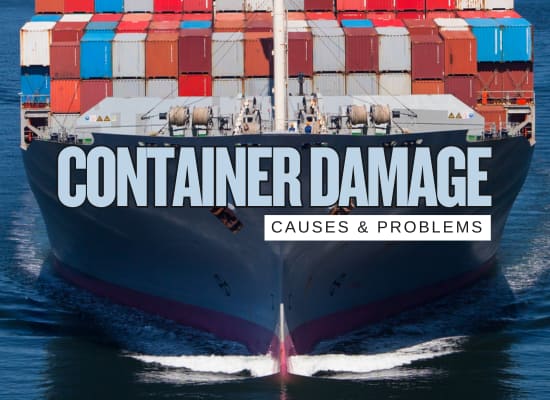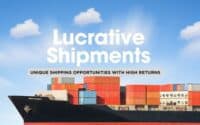Top 10 Causes of Container Damage (and How to Prevent Them)

Container damage remains one of the most persistent operational risks in maritime logistics—impacting cargo integrity, vessel efficiency, and bottom-line performance. Whether through structural failure, corrosion, or mishandling, the consequences can range from costly claims to significant delays. This guide outlines the top 10 most common causes of container damage, along with practical strategies to prevent, identify, and address each issue—ensuring greater reliability, compliance, and cost control across your fleet operations.

We welcome your feedback, suggestions, corrections, and ideas for enhancements. Please click here to get in touch.
ShipUniverse: Container Damage Loss Estimator
| Total Containers Handled Annually: | |
| Percentage of Containers Damaged: | |
| Average Repair Cost per Container ($): | |
| Average Replacement Cost per Container ($): | |
| Average Cargo Loss per Incident ($): | |
| Insurance Deductible ($): | |
| Projection Years: | |
| 🧮 Estimated Total Annual Loss: - | |
| 🟢 Risk Level: Low | |
⬇️ Top 10 Causes of Container Damage
Incorrect lifting, dropping, or unbalanced handling is one of the most common causes of container damage. Whether at port, onboard, or during inland transfer, rough handling with cranes or forklifts can twist frames, bend panels, and misalign doors—leading to costly repairs, cargo delays, or failed inspections.
🔧 Common Damage:- Dented walls, buckled roofs, and floor deformation.
- Twisted or cracked corner castings from uneven lifting.
- Misaligned or jammed doors due to off-center handling.
- Use certified, experienced operators for all crane and forklift operations.
- Always lift using correct rigging and twistlock systems to prevent stress concentration.
- Implement visual inspections and enforce SOPs at every handling point.
- Realign frames and doors using specialized jigs or hydraulic tools.
- Repair or replace bent panels and damaged castings through welding and reinforcement.
- Assess full structural integrity before placing the unit back in service.
- Track repeat damage types across terminals to spot patterns—some issues stem from specific ports or equipment being out of spec.
Exceeding a container's weight capacity or improperly distributing cargo can compromise structural integrity, leading to floor damage, wall bulging, and increased risk of tipping during transit. Such practices endanger cargo safety, vessel stability, and crew well-being.
🔧 Common Damage:- Cracked or weakened floorboards due to excessive weight.
- Bulging or deformed sidewalls from uneven load pressure.
- Compromised structural integrity, increasing the risk of container collapse.
- Adhere strictly to the container's maximum gross weight limit as specified on its CSC plate.
- Utilize load planning software to ensure even weight distribution across the container.
- Place heavier items at the bottom and center of the container to maintain balance and stability.
- Regularly train staff on proper loading techniques and the importance of weight compliance.
- If overloading is detected before transit, redistribute the cargo to comply with weight regulations.
- For minor floor damage, reinforce or replace affected floorboards to restore integrity.
- In cases of significant structural compromise, decommission the container to prevent safety hazards.
- Implement a routine inspection protocol to verify weight distribution before departure, reducing the likelihood of in-transit incidents and ensuring compliance with international shipping standards.
Improper stacking techniques and exceeding weight limits can compromise container stability, leading to structural failures, cargo loss, and safety hazards. Ensuring correct stacking procedures is vital for maintaining the integrity of container stacks during transit and storage.
🔧 Common Damage:- Collapsed container stacks due to misalignment or overloading.
- Structural deformation, such as buckled walls or roofs, from excessive weight.
- Damaged corner castings and locking mechanisms from improper stacking.
- Ensure accurate weight declarations for all containers to maintain proper load distribution.
- Follow established stacking protocols, placing heavier containers at the bottom and lighter ones on top.
- Regularly inspect containers for structural integrity before stacking.
- Utilize appropriate securing devices, such as twist locks and lashing rods, to stabilize stacks.
- Immediately restack any improperly stacked containers to prevent further damage.
- Repair or replace damaged containers to ensure they meet safety standards.
- Review and revise stacking procedures and training to prevent recurrence.
- Implement a monitoring system to track container weights and stacking configurations, ensuring compliance with safety regulations and reducing the risk of stack collapses.
Shipping containers are constructed from Corten steel, designed to withstand harsh marine environments. However, prolonged exposure to saltwater, high humidity, and standing water can lead to corrosion, compromising structural integrity and reducing lifespan.
🔧 Common Damage:- Surface rust on walls, roofs, and doors.
- Deep pitting and structural weakening over time.
- Compromised door seals leading to water ingress.
- Conduct regular inspections to detect early signs of rust.
- Ensure the container is placed on a well-drained surface to prevent water accumulation.
- Apply protective coatings, such as rust-inhibiting primers and marine-grade paint, to create a barrier against moisture.
- Maintain proper ventilation to reduce internal condensation.
- Remove surface rust using wire brushes or sandblasting, then apply rust converters to neutralize any remaining corrosion.
- Repair or replace corroded sections to restore structural integrity.
- Reapply protective coatings after repairs to prevent future corrosion.
- Elevate containers off the ground using concrete blocks or steel beams to minimize exposure to ground moisture and improve air circulation beneath the unit.
Door seals and gaskets are critical components that ensure the watertight and airtight integrity of shipping containers. Over time, these rubber elements can degrade due to exposure to environmental factors and frequent use, leading to potential water ingress, contamination, and compromised cargo security.
🔧 Common Damage:- Cracked or brittle rubber seals resulting from prolonged exposure to UV rays and temperature fluctuations.
- Detached or loose gaskets due to adhesive failure or physical wear.
- Compressed or misshapen seals that no longer provide an effective barrier against moisture and pests.
- Conduct regular inspections of door seals and gaskets, checking for signs of wear, cracks, or detachment.
- Clean seals periodically to remove dirt, salt, and debris that can accelerate deterioration.
- Apply appropriate rubber conditioners or protectants to maintain flexibility and prolong lifespan.
- Ensure proper alignment and operation of container doors to prevent undue stress on seals.
- Remove damaged or worn seals by carefully detaching them from the door edges.
- Clean the surface thoroughly to remove old adhesive and contaminants before installing new seals.
- Install high-quality replacement gaskets, ensuring they match the container's specifications and are securely affixed.
- Test the integrity of the new seals by checking for light leaks or drafts when the doors are closed.
- When replacing door seals, consider using seals made from EPDM rubber, known for its durability and resistance to environmental factors, to enhance the longevity and performance of the container's sealing system.
Port operations involve the rapid movement of containers using heavy machinery such as cranes, forklifts, and straddle carriers. Accidents during these operations can lead to significant container damage, posing risks to cargo integrity, worker safety, and overall port efficiency.
🔧 Common Damage:- Dents and structural deformations from collisions with equipment or other containers.
- Punctures or tears resulting from mishandling or dropped containers.
- Compromised corner castings and locking mechanisms due to improper lifting techniques.
- Implement comprehensive training programs for port personnel on safe handling practices and equipment operation.
- Enforce strict adherence to established safety protocols and standard operating procedures during all handling activities.
- Conduct regular maintenance and inspections of handling equipment to ensure optimal performance and reduce the risk of mechanical failures.
- Utilize advanced technologies, such as automated systems and real-time monitoring, to enhance situational awareness and prevent accidents.
- Assess the extent of damage immediately and determine the feasibility of on-site repairs versus the need for container replacement.
- Perform structural repairs, including welding and reinforcement, to restore the container's integrity.
- Replace damaged components, such as doors, panels, or locking mechanisms, to ensure the container remains secure and functional.
- Document all incidents and repairs meticulously to inform future prevention strategies and improve safety measures.
- Establish a culture of safety and accountability within port operations by encouraging reporting of near-misses and conducting regular safety audits. This proactive approach can identify potential hazards before they result in accidents, thereby reducing container damage and enhancing overall operational efficiency.
Shipping containers are designed to endure harsh maritime conditions; however, extreme weather events such as storms, high winds, and turbulent seas can lead to significant damage or loss. These conditions can cause containers to shift, sustain structural damage, or be lost overboard, posing risks to cargo integrity and maritime safety.
🔧 Common Damage:- Containers lost overboard due to heavy rolling and pitching of the vessel.
- Structural damage from violent impacts with waves or other containers.
- Water ingress resulting from compromised seals or structural breaches.
- Implement robust lashing and securing protocols to ensure containers remain in place during adverse weather conditions.
- Utilize advanced weather forecasting tools to plan routes that avoid severe weather systems.
- Regularly inspect and maintain lashing equipment and container integrity to withstand harsh conditions.
- Conduct thorough inspections of containers and cargo after encountering severe weather to assess and document any damage.
- Perform necessary repairs to restore structural integrity before containers are returned to service.
- Review and update operational procedures based on lessons learned to enhance preparedness for future severe weather events.
- Establish a proactive communication protocol between the vessel's crew and shore-based operations to monitor weather conditions and make timely decisions regarding route adjustments or cargo securing measures, thereby minimizing the impact of severe weather on container safety.
Shipping containers are often targeted for vandalism and theft, leading to compromised cargo, financial losses, and operational disruptions. Unauthorized access can result in stolen goods, damaged containers, and increased liability for shipping companies.
🔧 Common Damage:- Broken or tampered locks and seals.
- Graffiti and exterior defacement.
- Structural damage from forced entry attempts.
- Install high-security locks and tamper-evident seals to deter unauthorized access. :contentReference[oaicite:0]{index=0}
- Utilize surveillance systems, including cameras with night vision capabilities, to monitor container storage areas. :contentReference[oaicite:1]{index=1}
- Position containers in less visible or accessible areas, complemented by security lighting and fencing, to reduce the likelihood of vandalism or theft. :contentReference[oaicite:2]{index=2}
- Implement tracking technologies with geofencing capabilities to monitor container movements and receive alerts for unauthorized activity. :contentReference[oaicite:3]{index=3}
- Replace compromised locks and seals immediately to maintain security integrity.
- Repair structural damages promptly to prevent further deterioration and ensure container usability.
- Remove graffiti and apply protective coatings to deter future vandalism.
- Regularly review and update security protocols, and conduct audits to identify and address vulnerabilities in container storage and transport processes.
Over time, shipping containers can deteriorate due to constant exposure to harsh environmental conditions and the rigors of transportation. Utilizing aging or substandard containers poses significant risks to cargo safety, structural integrity, and overall operational efficiency.
🔧 Common Damage:- Rust and corrosion compromising the container's structural strength.
- Warped or weakened flooring unable to support designated weight loads.
- Malfunctioning or degraded door mechanisms and seals leading to security and weatherproofing issues.
- Implement a rigorous inspection and maintenance schedule to identify and address signs of wear and tear promptly.
- Retire containers that have exceeded their recommended service life or exhibit irreparable damage.
- Source containers from reputable manufacturers and suppliers to ensure compliance with industry standards and quality benchmarks.
- Conduct thorough assessments to determine the extent of damage and feasibility of repairs.
- Perform necessary refurbishments, including rust treatment, floor replacement, and door mechanism repairs, to restore container integrity.
- When repairs are not cost-effective or feasible, responsibly decommission and recycle the container.
- Regularly review and update procurement policies to prioritize the acquisition of high-quality containers, thereby reducing long-term maintenance costs and enhancing operational reliability.
Accidental drops or impacts during lifting operations pose significant risks to container integrity, potentially leading to structural damage, compromised cargo, and operational delays. Such incidents often result from equipment malfunctions, human error, or inadequate safety protocols. :contentReference[oaicite:0]{index=0} 🔧 Common Damage:
- Dents, scratches, or punctures on container surfaces.
- Misalignment or damage to corner castings and locking mechanisms.
- Structural deformations affecting the container's load-bearing capacity.
- Ensure all lifting equipment undergoes regular maintenance and inspections to prevent mechanical failures.
- Provide comprehensive training for crane operators and handling personnel to minimize human errors during operations.
- Implement strict adherence to safety protocols, including clear communication and standardized lifting procedures.
- Utilize appropriate lifting gear, such as twist locks and spreaders, and ensure they are correctly engaged before lifting.
- Promptly assess and document any damage to determine the necessary repairs or replacements.
- Repair structural damages, including welding and reinforcing affected areas, to restore integrity.
- Replace damaged components, such as locks or corner castings, to ensure secure handling and compliance with safety standards.
- Regularly review and update lifting procedures and safety protocols based on incident reports and technological advancements to continually enhance operational safety and efficiency.
Table Summary
| ShipUniverse: Top 10 Causes of Container Damage | |||
|---|---|---|---|
| Cause | Damage | Prevention | Fix |
| 1️⃣ Improper Handling by Cranes or Forklifts | Dents, cracks, misaligned doors, twisted frames from rough handling or dropping. | Certified operator training, use of proper lifting equipment, and supervision. | Realignment, welding, or replacing damaged parts like frames or doors. |
| 2️⃣ Overloading or Uneven Weight Distribution | Floor cracking, bulging walls, potential collapse of container structure. | Adhere to weight limits and use load planning software to evenly distribute weight. | Redistribute cargo or replace floorboards; scrap containers with severe damage. |
| 3️⃣ Stacking Errors or Excessive Stack Weight | Collapsed stacks, roof deformations, damaged twist-locks, and sidewall buckling. | Follow proper stacking limits, use twistlocks, and implement visual inspections. | Re-stack containers correctly and replace damaged roofs or panels. |
| 4️⃣ Corrosion from Saltwater or Moisture Exposure | Rust on walls, weakened floors, and leaks due to long exposure to salty air. | Apply protective coatings, inspect containers regularly, and avoid pooling water. | Sandblasting, rust treatment, and re-coating with marine-grade paint. |
| 5️⃣ Worn or Damaged Door Seals and Gaskets | Water ingress, mold, and temperature fluctuations that affect cargo quality. | Inspect and lubricate seals, replace gaskets when damaged, and clean them regularly. | Replace gaskets, reseal doors, or realign locking mechanisms for better sealing. |
| 6️⃣ Accidents During Port Handling | Impact damage, misalignment, structural breaches from mishandling at ports. | Implement strict lifting protocols, use soft landing pads, and perform equipment maintenance. | Repair dents or cracks, weld structural parts, and ensure safe handling in the future. |
| 7️⃣ Severe Weather and Rough Seas | Shifting cargo, container deformation, and possible loss overboard. | Proper lashing, route planning to avoid storms, and secure containers well in rough seas. | Inspect containers after weather events, reinforce damaged areas, and replace if needed. |
| 8️⃣ Vandalism or Theft Attempts | Broken locks, forced doors, and graffiti damage. | Install high-security locks, use GPS tracking, and monitor with surveillance systems. | Replace locks and seals, clean graffiti, and reinforce doors to avoid future break-ins. |
| 9️⃣ Aging or Substandard Containers | Leaks, structural fatigue, and floor damage from wear and tear over time. | Regular inspections and maintenance, phase out old containers, and avoid substandard units. | Refurbish floors, treat rust, or replace containers if they’re beyond repair. |
| 🔟 Drops or Impacts from Lifting Equipment | Crushed roofs, bent corner castings, and twisted frames. | Maintain lifting equipment, ensure proper operator training, and use safety protocols. | Assess damage and perform welding or structural repairs, or replace severely damaged units. |

Do you have a Maritime Product or Service that may be of interest to Shipowners? Tell us about it here!
Do you have feedback or insights? Please reach out to editor @ shipuniverse.com



